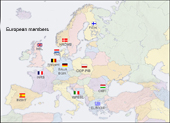
Topic Centre Occupational Safety and Health 2010
Project No. IFA 0092

Map marked with European Partners, Picture: EU
Status:
completed 01/2011
Aims:
In 2009, the European Agency for Safety and Health at Work (EU-OSHA) set up its Topic Centre Occupational Safety and Health (TC-OSH). TC-OSH was scheduled to run for four years. Around 15 projects are conducted each calendar year. In 2010, the focus lay upon the areas of risk perception, the working conditions of women, preventive healthcare, maintenance work, and evidence-based prevention. The IFA was involved in the projects concerning new risks and trends in the safety and health of women at work, and in the revision of FAQs (frequently asked questions with model answers) on the Agency's website. BG BAU, the German Social Accident Insurance Institution for the building trade, was brought in to compile examples of evidence-based prevention from the construction sector. The IFA was also actively involved in the management of TC-OSH and in the Topic Centre's Advisory Group.
Activities/Methods:
The work of all projects was divided among the members of an international consortium by a tender procedure conducted by the Agency. The foci of the topic of the working conditions of women lay upon specific health problems particularly associated with cancer, and violence at work. A statistical summary was produced of trends in the employment and integration of women on the labour market, broken down by age and Member State. Examples of good practice for better integration of the gender-specific aspects within OSH were presented. Searches were conducted in literature databases and in sources of statistical data, in both cases at both national and international level.
For the evidence-based examples from the field in the area of construction, the main risks were identified, and prevention measures (training, health promotion, OSH management systems) with measurable OSH effects and low administrative overhead developed for them.
Results:
EU-OSHA plans to publish the results from the TC-OSH projects in printed form and/or on its website. A report is for example to be published based upon the projects conducted in 2009 and 2010 concerning working conditions for women. This report shows that for the most part, occupational safety and health does not differentiate between the needs of women and men, and that despite their working conditions being demonstrably different, it is still geared too strongly to a "standard employee" - who is male. Greater consideration in occupational safety and health of the differences between the sexes would appear appropriate, since women filled 59% of all new jobs in Europe between 2000 and 2009, and the proportion of women in employment continues to rise. Women are generally employed in the education, health or retail sectors. They substantially more frequently work part-time than men (80% of all employees working part-time are women) and in informal employment. Their work is therefore frequently characterised by contact with customers or patients, which leads to women being subjected in particular measure to stress caused by the psychosocial aspects of their work. Domestic work is one of the fastest-growing sectors in Europe, and most of the associated jobs are filled by women. Informal and domestic work exposes women to a particular risk of discrimination on the basis of their sex, class or geographical origin, and of bullying and violence. Owing to their employment conditions often being unstable, women benefit less than men from occupational safety and health. OSH must address the psychosocial working conditions of women much more strongly in the future. Consideration must be given to the female anatomy during the development of ergonomic aids and personal protective equipment. Whereas women are less frequently the victims of occupational accidents, men and women face similar work-related health problems. Musculoskeletal diseases are the most significant category.
An updated version of the FAQ (frequently asked questions) can also be found on the EU-OSHA website. The DGUV was involved in the revision of a total of 66 existing FAQs under the following headings: "Accident Prevention" (18), "Musculoskeletal Disorders" (4), "Education: Occupational Safety and Health Management" (11), "Education: Accident Prevention" (6), "Education: Psychosocial Issues" (11), "Education: Occupational Health Issues" (11) and "Disabled People" (5).
The results from the TC-OSH projects are being incorporated into the EU Strategy on OSH.
Last Update:
16 Feb 2011Project
- European Agency for Safety and Health at Work
- Institut für Arbeitsschutz der Deutschen Gesetzlichen Unfallversicherung (IFA)
- Berufsgenossenschaft der Bauwirtschaft
- Bundesanstalt für Arbeitsschutz und Arbeitsmedizin (BAuA)
- Finnish Institute of Occupational Health (FIOH), Finland
- Central Institute for Labour Protection - National Research Institute (CIOP-PIB), Poland
- Hellenic Institute for Occupational Health and Safety (ELINYAE), Greece
- Health and Safety Laboratory (HSL), United Kingdom
- Instituto Nacional de Seguridad e Higiene en el Trabajo (INSHT), Spain
- Instituto Superiore per la Prevenzione e la Sicurezza del Lavoro (ISPESL), Italy
- Hungarian Institute of Occupational Health (OMFI), Hungary
- PREVENT, Belgium
- TNO, The Netherlands
- Faculdade de Ciencias e Tecnologia da Universidade Nova de Lisboa, Portugal
-cross sectoral-
Type of hazard:-various
Catchwords:Gesundheitsförderung, Unfallverhütung, Arbeitsschutzdienste
Description, key words:risk assessment, risk observatory, work-related risks, good practice, occupational safety and health